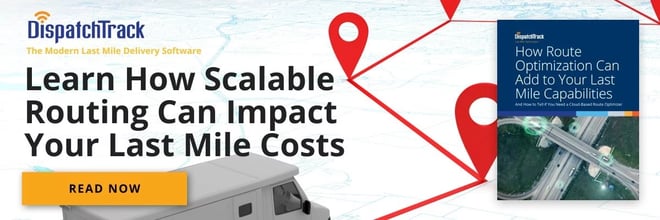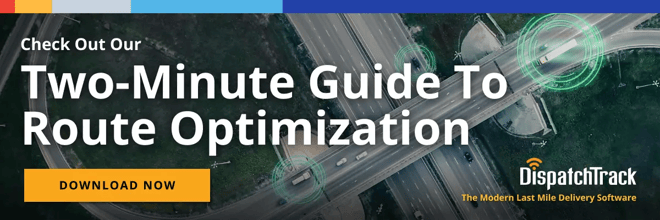Operating a trucking business has become more costly in recent years, which puts more pressure on smaller fleets to find ways to optimize their operations. One of the main challenges in maximizing revenue for truckers is ensuring efficient routing. Poor truck route planning, after all, results in delivery delays, higher operating costs, and ultimately, lower profitability.

For smaller fleets, it might be tempting to use a free route planning application like Google Maps to overcome routing challenges. While Google Maps, Waze, and other similar tools can certainly be helpful, there are a number of reasons why they’re not ideal for optimizing truck routes.
The Challenges of Route Planning
Route planning isn’t merely about ensuring that trucks get from one point to another. It’s a complex process filled with many challenges. When truck routes aren’t optimized, there can be a number of real implications:
Inability to meet expected times of arrival (ETAs)
Poorly planned routes are often the result of failing to take into consideration various important variables in the delivery process such as type of cargo, vehicle dimension, and real-time weather and road conditions, to name a few. Failing to factor in such variables not only causes delays in the delivery but can also mean failing to meet the delivery windows and ETAs that you’ve promised to customers.

Higher fuel consumption
The absence of route optimization translates to higher fuel consumption. In contrast, finding the most efficient routes enables businesses to use less fuel per stop by minimizing the distance that trucks have to travel. An efficient route planner can also cut down wasteful truck idling.
Reduced route capacity
When you’re not taking the optimal routes between stops, you may be making fewer deliveries per day than you should be. This can result in situations where you think you need more trucks in order to handle order volumes, when what you really need is better truck routes.
The right truck route planner helps address these challenges. Having a tool that not only utilizes AI and machine learning but also considers real-time information can help you find optimal routes, provide customers and clients with accurate ETAs and ensure delivery efficiency.
Is Using Google Maps for Trucks a Good Idea?
Many casual drivers use Google Maps to find the best route. However, there's a big difference between commercial trucking and driving for personal purposes. The goal of getting to one's destination quickly may be the same, but the priorities, scale, and delivery requirements are quite different. In commercial truck routing, you need to consider the size of the vehicle, the heights of overpasses, the widths of roads, and other trucking-specific factors on top of the usual driving constraints.
Simply put, Google Maps doesn’t offer the trucking-specific functionality you need to create accurate routes and ETAs. Not only does it fail to account for drive-time differences between trucks and cars, it also doesn’t give you the ability to adjust based on load type, vehicle time, service time, driver skill, etc.
Here are some additional considerations for commercial truck routing.
- Time tracking: Truck drivers need to manage their workloads, keep track of their hours so they get paid, and comply with the government's rules for long-haul trucking. Free route planning apps don’t provide any way to manage these things.
- Number of stops and distance traveled: Many truckers cross state lines during a single trip. Long-haul trucking means more planned stops and mandatory driving breaks, which can’t be optimized in Google Maps.
- Vehicle type: box trucks, to say nothing of 10- or 18-wheelers, don’t move as quickly on the road as SUVs or sedans. If you can’t account for vehicle type, this difference will lead to late deliveries and other disruptions.
All of the above-mentioned considerations are among the primary reasons why you simply cannot rely on Google Maps for trucks and truck routing. Google Maps, after all, was created for the use of private drivers so they can find directions easily. It's useful for finding accurate directions and quickest routes from point A to point B, but it can't plan for the complex routes or constraints that truckers have to factor in.
On top of all this, there’s a lack of automation. Drivers also have to manually add stops as they go to get around Google Maps’ cap of 10 stops. Simply put, truckers cannot optimize their fleet operations with Google Maps or other consumer navigation apps.
The Benefits of Truck Route Planning Software
Google Maps’ limitations might seem annoying—after all, who wants to shell out for a SaaS routing solution if they don’t have to? But the right route optimization engine with the right features can actually add value and help you achieve a positive ROI. How? There are a few distinct ways:
Faster and more accurate planning
Automating route planning by using software is more efficient and effective than manual planning. Conventional route planning takes many hours but is still inaccurate, because the manual process cannot account for many variables affecting delivery times.

Lower fuel bills
Fuel expenses account for a significant chunk of your fleet's overall operating costs. Optimizing routes means cutting down the miles traveled and fuel consumption of each truck in the fleet, which can result in significant cost savings.
Smart long-haul route planning
Fleet managers using the right fleet routing software can plan ahead for long-haul routes that entail mandatory driving breaks and overnight stops by just clicking a few buttons.
Live tracking
Advanced route planning apps and software solutions for truckers allow fleet managers, dispatchers, and customers to track the delivery truck in real-time and provide stakeholders with live, accurate ETAs.
Improved productivity
Route optimization software allows you to fit in more orders for each shift of all drivers. This means you can increase delivery capacity using the same number of vehicles and employees.
Higher customer satisfaction
Effective route planning allows businesses to meet promised delivery time windows. Meeting ETAs and delivering on time according to customers' preferences results in higher overall customer satisfaction.
There's no denying that navigational tools like Google Maps are useful, but they’re not the best tool for commercial truckers. Luckily, the right truck router can help businesses lower costs, successfully ETAs, and provide great delivery service to customers.